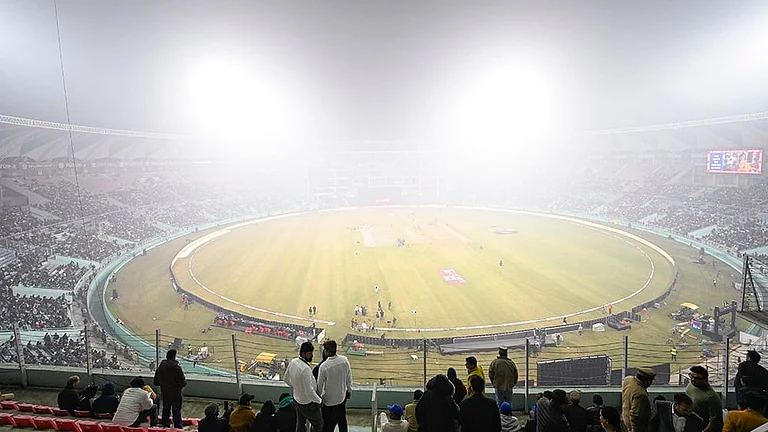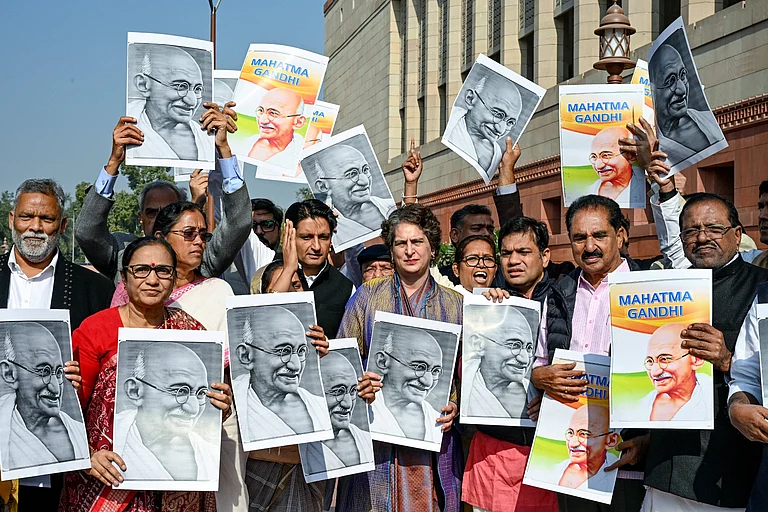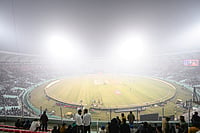THE Bombay High Court bench of Judges B.P. Saraf and M.S. Rane is currently deliberating over their judgement on Case no 2456. Arguments on both sides—the plaintiffs, Centre for Indian Trade Unions (CITU) and Abhay Mehta, and the defendants, the Union of India, Maharashtra state, Dabhol Power Company (DPC) and others—have been completed. There have been some interesting histrionics in court. During one session, defence lawyer Ram Jethmalani asked the judges to be careful of their stance since it could lead to "political complications".
Undoubtedly. For, the petitioners' basic contention may have put the Shiv Sena-BJP government in Maharashtra in a classic Catch-22 situation. As is well-known, the government filed a case against the previous Congress government for finalising a 'fraudulent' deal for the Enron power project, and then did a volte face to renegotiate and finally set up another deal with Enron. Now, according to the law of the land, if the new deal is, as was earlier claimed by the Manohar Joshi government, very different from the earlier one, it's illegal, because it did not have the mandatory clearances from the Central Electricity Authority (CEA). If, however, the government now claims that the differences between the original and the renegotiated one are 'minor' (so that the previous clearances remain valid), then the Shiv Sena-BJP regime could end up with a lot of egg on its face.
The government's quandary is possibly indicated by its final affidavit presented to the High Court. In which it claims that it had filed the case against its predecessor on the basis of media reports.
So are the changes major or minor? Very minor, as documents clearly show. The substantial part of the project cost—Rs 1,580 crore for the regassification plant—was initially shown to be absent in the renegotiated deal, and then quietly added back to the project without public disclosure. The defence feels that public disclosure was not necessary since the ultimate tariff would remain unaffected. The petitioners wonder how that could be, given the additional cost.
The government's final argument: that even if renegotiating the deal was a mistake, it was still in public interest and was the best possible deal under the circumstances. Jethmalani has pleaded that it's simply a case of an irresponsible government turning responsible. While the decision to scrap the deal was a political one, the renegotiation was "good economic judgement".
Most attempts by the petitioners to detail their plea to prove otherwise have been dismissed by the judges, who said that they were not going to get into the "technical details". Some of these details are available with Outlook.
The poweavailable withr tariff projections indicated by MSEB to apex power sector regulatory authority CEA ( see Table ) are markedly lower than the various projections made by the World Bank, and even by MSEB's own financial adviser. While the World Bank and MSEB's financial adviser worked out various projections based on assumptions of the rupee depreciating against the dollar at rates ranging from 1 per cent to 7 per cent, when MSEB decided to give these details to CEA, it preferred to assume that till the year 2014, the rupee would remain rock-steady at Rs 32 to a dollar (current rate: around Rs 35.70). However, even if one agrees with MSEB's assumption, the tariff for the year 2014 works out to Rs 4.53 per KWh, significantly higher than the Rs 4.14 MSEB has indicated to the CEA.
Naturally, then, projected estimates of how much MSEB will pay DPC to buy power from it differ radically from one another. MSEB, in its official submission to CEA, believes it will pay about Rs 100,000 crore over the contracted period. The World Bank feels it would end up paying between Rs 142,000 and Rs 145,000 crore. And MSEB's financial adviser says that the sum will be as much as between Rs 250,000 crore and Rs 266,000 crore!
Even the exact details of the financial package worked out for the Dabhol project differ in various submissions made to the various agencies. As per figures given to CEA, the interest costs being paid by the project annually are nearly Rs 26 crore higher than the figure submitted to IDBI ( see Table 2 ). What is the actual financial package? How much will MSEB actually pay DPC for power? How much is the Maharashtra consumer actually going to end up paying? How could a state government cancel a massive project of such economic significance based on media reports?
Some other questions. On April 30, 1993, the World Bank wrote to the Ministry of Finance that "the LNG-based project as presently formulated is not economically viable," and that it is "not part of the least cost option for Maharashtra's power development." Interestingly, Enron remained unphased. Why did, in a letter dated June 23, 1993 available with Outlook , Enron top manager Joseph Sutton write to the DPC, that "the World Bank opinion can be changed"? Three months later, on September 20, the CEA informed the government the Dabhol project was "not the least cost option". Why were so many caveats disregarded?
Why did the Foreign Investment Promotion Board, on November 11, 1993, need to reassure the CEA that Finance Secretary Montek Singh Ahluwalia had observed that the cost of Dabhol power at 7.506 cents per unit was "more or less" the same as that for other similar projects in Maharashtra, when there were no other similar projects then in Maharashtra, or for that matter, in India? Why did the CEA finally give its clearance to the capital cost of the project based on the following logic (letter dated December 23, 1994): "The cost of power has been found reasonable by the Ministry of Finance and the CEA feels that since the cost of power is to be derived from the capital cost, the capital cost of Dabhol project may also be considered reasonable"? Didn't the CEA study the economic reasonableness of the project on its own, as it should have?
Why did DPC say, in its letter to CEA dated March 7, 1996, detailing the "minor" changes, that "there has been no change in the capacity charges for Phase I", whereas the Government of Maharashtra had claimed to have reduced capacity charges as a result of reductions in capital costs?
Both the petitioners and Enron have been pushing for an early judgement on Case 2456. Enron claims it is losing Rs 85 crore per day of delay. It has even threatened to back out if matters aren't expedited. Whichever way the judgement goes, no one could disagree about the urgency and significance of the case.


























